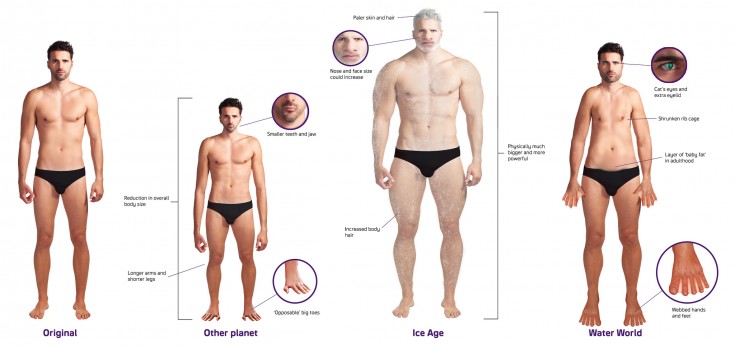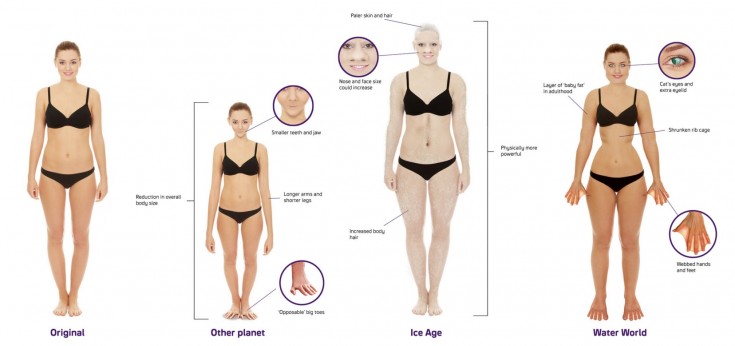https://youtu.be/TLJHKtP5U50
Changes in climate, the development of technology or lack of natural resources will make the human body evolve in dramatic ways to survive in possible future habitats – including changes such as developing ‘opposable’ big toes, increasingly similar length limbs and cat’s eyes with translucent eyelids.
To celebrate the premiere of futuristic drama Extant Season 2 (13th January, 9pm on Syfy UK), Syfy challenged acclaimed paleoanthropologist Dr Matthew Skinner, School of Anthropology and Conservation at University of Kent, to predict how the human body would naturally evolve to survive different future habitat scenarios. His predictions for each scenario were then brought to life by digital artist Quentin Devine.
Habitat scenario: Water World
Global warming has caused sea levels to rise, leading to the human population constructing and inhabiting underwater or part-aquatic communities.
Dr Skinner predicts evolutionary changes to the human body would therefore be:
- Webbed hands and feet: Regular underwater foraging would lead to the evolution of longer fingers and toes – which would then likely develop ‘webbed’ interconnecting skin to enable easier swimming.
- Layer of ‘baby fat’ in adulthood: Due to the cold environment of being submerged in water regularly, we would maintain a layer of ‘baby fat’ into adulthood as an insulator.
- Shrunken rib cage: To accommodate the regular activity of gathering resources at a shallow-water depth, ‘artificial gills’ would likely be developed as breathing apparatus. These would extract oxygen from the water and deliver it directly into the bloodstream, resulting in a marked reduction in the need for lung capacity, which over time would cause us to develop a shrunken rib cage.
- Reduced body hair: To lessen drag in the water during swimming, our body hair would reduce.
- Cat’s eyes and extra translucent eyelids: We may evolve a tapetum lucidum, an additional layer in the retina (like cat’s eyes) that would improve our vision in low light conditions such as underwater. Additionally, we might re-evolve a nictitating membrane (similar to an extra translucent eye lid) to also protect the eye while underwater.
Habitat scenario: The Second Ice Age
An asteroid has hit Earth, resulting in moisture and dust overwhelming the atmosphere and blocking out sunlight. This causes worldwide temperatures to plummet, initiating a second Ice Age.
Dr Skinner’s predicts this scenario would include a major population crash, as we would be unprepared for this type of phenomenon. Therefore our technological sophistication would drastically reduce due to a loss of expertise, raw materials and manufacturing possibilities.
Dr Skinner’s predicted evolutionary changes to the human body:
- Paler skin and hair: The lack of sunlight would cause our skin and hair to become paler to improve the absorption of vitamin D.
- Nose and face size could increase: As a means of more efficiently warming inhaled cold air in the nasopharynx, the area behind the nose.
- Physically more powerful, particularly males: Reduced resources and technologies would result in physical power being an important attribute to gather resources and survive; particularly for males, who would have to assert their dominance to attract a mate physically rather than mentally, as with gorillas in the current natural world. Females would also become physically more muscular in reaction to surviving in the harsh environment.
- Increased body hair: Both sexes would see an increase in body hair as a means of insulation.
Habitat scenario: Colonising Another Planet
Advances in technology as well as depleting resources on Earth mean that the human race look to inhabit another planet. Predictions are made for a weightless environment, which could be conceivably built as a closed-environment facility on different planets.
Dr Skinner’s predicted evolutionary changes to the human body:
- Longer arms and shorter legs: In an environment with a weaker gravitational pull, walking would be reduced. Our upper and lower limbs would therefore serve increasingly similar functions (like an orangutan, with legs used less to support body weight), and become increasingly similar in length.
- ‘Opposable’ big toes: Development of a divergent or ‘opposable’ big toe is also likely as it would allow us to grip with our feet as well as our hands in a weightless environment, making us more dexterous overall.
- Smaller teeth and jaw: The technological developments that allow us to inhabit another planet would also suggest that basic dietary requirements would be met through manufactured nutritionally-balanced non-solid substances. The most obvious relaxation of selective pressure would be on the teeth and jaws:
o Cooking and its associated softening of food, has led to a reduction in our tooth and jaw size over the last million years. For example, dental crowding in modern Brits shows the impact of small jaws and relatively too many teeth. Therefore, there could be a selection for a complete loss of teeth and a reduction in jaw and mouth size down to something you can fit a straw into, which would result in face size also becoming smaller. Theoretically, we might look more like newborns whose mouths only need to swallow, yet they still have large brains.
- Reduction in overall body size: Due to a lack of natural predators, as well as the reduced need for physical exertion, our overall body size would reduce. We may follow a common evolutionary phenomenon called ‘island dwarfing’ which occurs in a number of mammals when there is low resource availability and few predators.
Colin McLeod, Managing Director, UK and EM, NBCUniversal International Networks says, “It’s so exciting to look into the future and think about how we as humans could physically evolve. There are of course infinite futures we could predict, from those where we develop webbed feet or eyes more similar to a cat, to one where we are co-existing with alien life and AI, as imagined in the second season of Extant. In whichever way the future does develop, it certainly seems as though there could be some incredible changes to our lives as we know them!”
Dr Matthew Skinner says, “No matter what future scenario we find ourselves in, be it a ‘Water World’, ice age or indeed that of colonising another planet, the human race will strive to avoid extinction – ultimately, it’s a fight for survival!”
Extant Season 2 premieres on Wednesday 13th January, 9pm on Syfy


